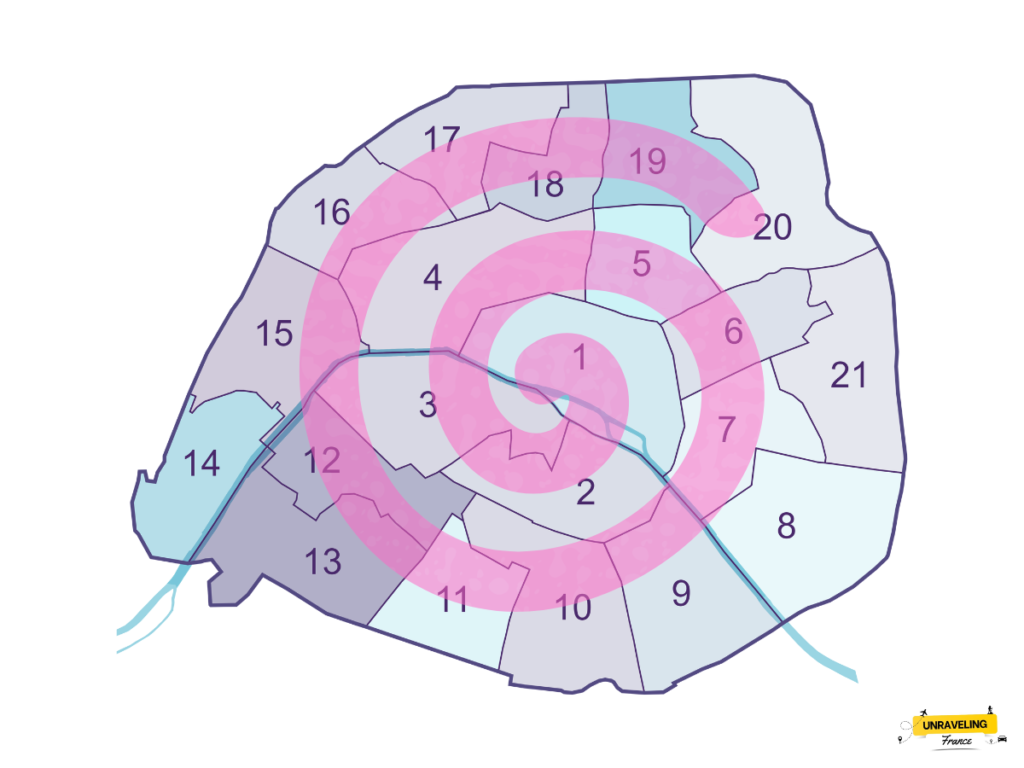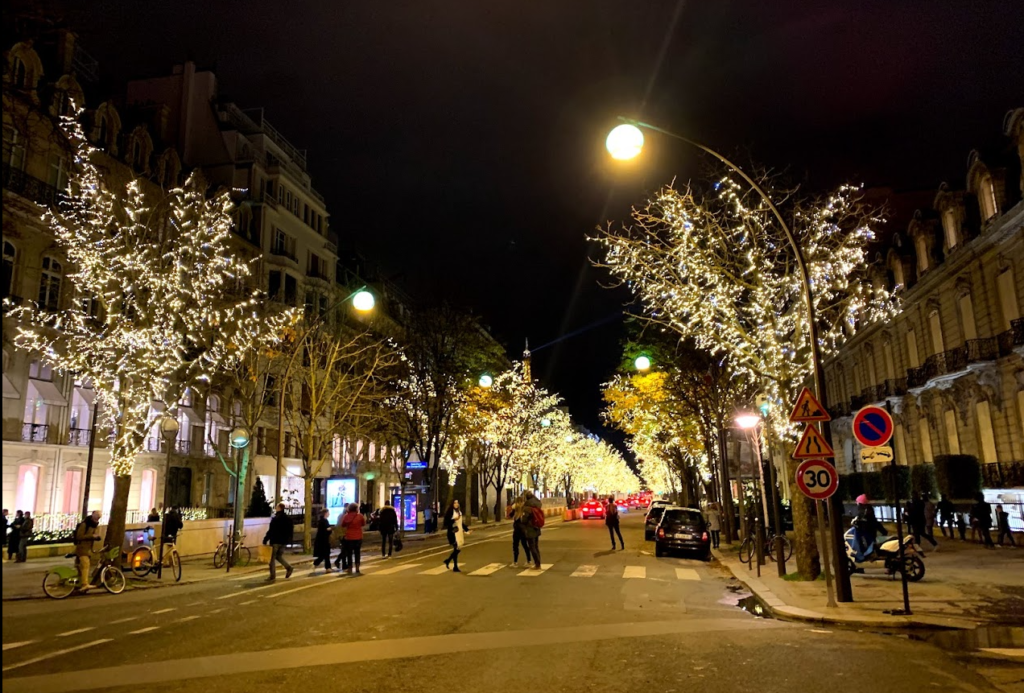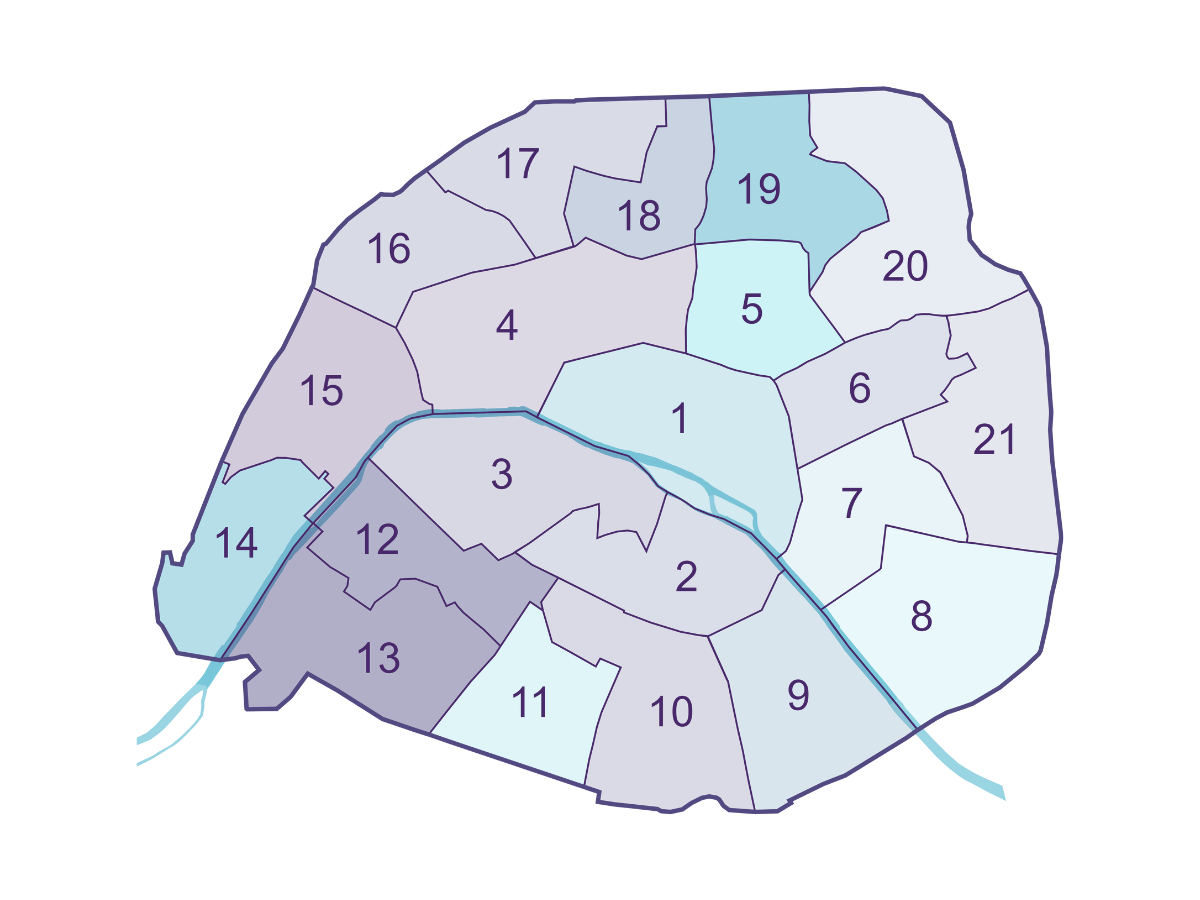Paris is a city made up of 20 unique districts, or “arrondissements,” each with its own distinct character, architecture, and attractions. From the historic center with the Louvre and Notre-Dame to the bohemian Montmartre and the modern neighborhoods in the south, each arrondissement offers travelers a unique atmosphere and diverse experiences. In this guide, you’ll find information on what to see in each district, the best places to stay, as well as hidden gems and practical tips to enhance your visit to the City of Light.
Brief History of Paris Arrondissements
Paris was divided into arrondissements (districts) in 1795, shortly after the French Revolution. At that time, the city consisted of 12 arrondissements. This administrative division was created to manage the rapidly growing city. In 1860, under Napoleon III and through the efforts of Baron Haussmann, the boundaries of Paris expanded, incorporating several nearby communes such as Passy, Montmartre, and Belleville. This led to the establishment of 20 arrondissements, which remain to this day. Since then, each arrondissement has its unique administrative structure, its mayor’s office, and distinctive characteristics.
Paris Arrondissements in Numbers
Paris today comprises 20 arrondissements, each with administrative independence and a unique cultural and historical flair. Arrondissements are numbered from 1 to 20, with each one having its own town hall, making them like mini-cities within Paris. The central arrondissements (1st, 2nd, 3rd, and 4th) are the historic heart of Paris, housing the oldest buildings and landmarks. The outer arrondissements (such as the 16th, 17th, 18th, 19th, and 20th) cover larger areas, have more modern buildings, and generally have lower population density, although they also retain historical neighborhoods.
Numbering and Spiral Arrangement of Arrondissements (Clockwise from the Louvre)
The numbering of Parisian arrondissements follows a unique spiral pattern, sometimes called the “snail” pattern. It starts in the center, with the 1st arrondissement near the Louvre, and spirals outwards in a clockwise direction. This makes the 1st arrondissement the most central, while the 20th is the outermost on the eastern side. This spiral layout aids navigation: the higher the arrondissement number, the farther it is from the historical center.

Each arrondissement has its own distinct characteristics, from densely built historic streets in the center to modern residential complexes and parks on the outskirts.
| District | Population 2022 | Population 2023 | Growth Percentage 2022 vs 2023 (%) | Growth Percentage 2022 vs 2023 (%) |
|---|---|---|---|---|
| Paris 1er Arrondissement | 15919 | 16030 | 0,30% | 0,70% |
| Paris 2e Arrondissement | 21119 | 21130 | 0,00% | 1,00% |
| Paris 3e Arrondissement | 32793 | 33402 | 0,90% | 1,60% |
| Paris 4e Arrondissement | 28324 | 29064 | 1,30% | 1,40% |
| Paris 5e Arrondissement | 56841 | 57380 | 0,50% | 2,70% |
| Paris 6e Arrondissement | 40209 | 39625 | -0,70% | 1,80% |
| Paris 7e Arrondissement | 47947 | 48520 | 0,60% | 2,30% |
| Paris 8e Arrondissement | 35123 | 35631 | 0,70% | 1,70% |
| Paris 9e Arrondissement | 58951 | 60168 | 1,00% | 2,80% |
| Paris 10e Arrondissement | 83543 | 83459 | -0,10% | 3,90% |
| Paris 11e Arrondissement | 142583 | 144292 | 0,60% | 6,70% |
| Paris 12e Arrondissement | 140954 | 140311 | -0,20% | 6,50% |
| Paris 13e Arrondissement | 178350 | 177833 | -0,10% | 8,30% |
| Paris 14e Arrondissement | 136368 | 133967 | -0,90% | 6,20% |
| Paris 15e Arrondissement | 227746 | 229472 | 0,40% | 10,70% |
| Paris 16e Arrondissement | 162061 | 162820 | 0,20% | 7,60% |
| Paris 17e Arrondissement | 164413 | 166336 | 0,60% | 7,80% |
| Paris 18e Arrondissement | 188446 | 191135 | 0,70% | 8,90% |
| Paris 19e Arrondissement | 181616 | 183211 | 0,40% | 8,50% |
| Paris 20e Arrondissement | 189805 | 192120 | 0,60% | 9,00% |
Must-Know Highlights, Architecture & Hidden Gems by Arrondissement
City Center (1st-4th Arrondissements): Historic Buildings and Monumental Architecture
- 1st Arrondissement (Louvre)
- Description: One of the oldest districts in Paris, it represents the heart of French monarchy and culture. This arrondissement is home to landmarks like the Louvre Museum, Tuileries Garden, Rue de Rivoli, and Royal Palace. It is one of the smallest arrondissements by area.
- Architecture: Historic buildings with Gothic and Classical elements. The facades are adorned with rich sculptures and columns, characteristic of the monarchy period. Rue de Rivoli is famous for its arcades running along the buildings.
- Hidden gems : Passage Richelieu — a hidden passage to the Louvre, once used by the royal family for private access. This is the perfect spot to avoid the crowds at the main entrance and immerse yourself in historic ambiance. Another gem is the Saint-Eustache Church at Les Halles Square, featuring stunning architecture and a lesser-known historical role.
- 2nd Arrondissement (Bourse)
- Description: Known as Paris’s business center, it houses the Paris Stock Exchange (Palais Brongniart), numerous offices, and textile trading centers. The Sentier area is also here, known for its cafes, shops, and theaters.
- Architecture: Dominated by 18th-19th century classical buildings with tall arched windows and formal facades reflecting its affluent business environment. This area also features many historic passages, such as the Passage des Panoramas.
- 3rd Arrondissement (Marais)
- Description: Home to the famous Marais Quarter, known for its narrow cobblestone streets, mansions, and old Parisian atmosphere. It includes the Picasso Museum, Carnavalet Museum, and several art galleries.
- Architecture: 17th-18th century buildings with half-timbered facades and Baroque decorative elements. The area maintains a historic charm, with mansion-style hotels like Hôtel Salé.
- Hidden gems : Hôtel de Sully, a mansion with a charming inner courtyard and garden rarely visited by tourists. This beautiful historic mansion allows visitors to feel the spirit of old Paris. Additionally, the Museum of Hunting and Nature offers a unique collection dedicated to wildlife and hunting.
- 4th Arrondissement (Hôtel-de-Ville)
- Description: A cultural heritage center featuring iconic landmarks like Notre-Dame Cathedral, Île Saint-Louis, and the Pompidou Center. It is a popular area among tourists.
- Architecture: A blend of Gothic and Modern styles, from the medieval Notre-Dame to the contemporary glass design of the Pompidou. Facades here are intricate and often feature sculptures and stained glass, especially on historic churches and the town hall.
Latin Quarter and Southwest Paris (5th-7th Arrondissements): Universities and Monumental Landmarks
- 5th Arrondissement (Pantheon)
- Description: The Latin Quarter is known for landmarks like the Pantheon and Sorbonne University, as well as its lively cafes and bookstores. This is the intellectual and student center of Paris.
- Architecture: Academic classicism with large buildings featuring columns, domes, and statues characteristic of the Pantheon style. Narrow streets retain their historical layout, and facades are dignified yet elegant.
- Hidden gems : Arenes de Lutece — an ancient Roman amphitheater hidden in a small park in the heart of the Latin Quarter. This is one of the few remaining Roman structures in Paris, near the Sorbonne, offering a peaceful place to explore.
- 6th Arrondissement (Luxembourg)
- Description: Known for Luxembourg Gardens and Saint-Germain and Saint-Michel Boulevards, this prestigious district attracts writers and artists.
- Architecture: Multi-story buildings in classical and Empire styles, with wide boulevards and spacious structures featuring balconies and arcades. The area exudes an affluent and historical ambiance.
- Hidden gem : Eugène Delacroix Museum Garden — a quiet, charming place with benches and greenery, perfect for escaping city bustle. This museum honors the life and work of French painter Eugène Delacroix
- 7th Arrondissement (Palais Bourbon)
- Description: Home to France’s iconic landmarks like the Eiffel Tower, Invalides, and Orsay Museum. It is one of the most prestigious arrondissements with high property prices.
- Architecture: Grand architecture with neoclassical, Gothic, and Empire elements. Large mansions, broad boulevards, and expansive parks create a unique atmosphere. The Eiffel Tower is a major symbol of both the arrondissement and the city of Paris.

Central and Northern Paris (8th-12th Arrondissements): Fashionable Boulevards and Cultural Centers
- 8th Arrondissement (Champs-Elysées)
- Description: Famous for landmarks like the Arc de Triomphe, Place de la Concorde, and Champs-Elysées. This area is known for its luxury shops and upscale restaurants.
- Architecture: Magnificent mansions, neoclassical facades, and broad avenues. Buildings along the Champs-Elysées are adorned with marble, decorative details, and intricate plasterwork.
- 9th Arrondissement (Opéra)
- Description: Centered around theaters and the Opéra Garnier, this arrondissement is bustling with shopping and entertainment options, including the Galeries Lafayette.
- Architecture: A mix of Baroque and Empire styles, especially notable in the Opéra Garnier with its domes and gold sculptures, as well as facades featuring columns and arches. Haussmann-style buildings are prominent.
- Hidden gem : Fragonard Museum, housed in an old building, tells the story of perfume-making. Visitors can learn about ancient methods of perfume production and even try their hand at creating scents
- 10th Arrondissement (Ennery de Saint-Martin)
- Description: Known for Canal Saint-Martin and the train stations Gare de l’Est and Gare du Nord, this is an affordable area with a creative vibe.
- Architecture: A blend of 19th-century residential buildings and historic industrial structures along the canal. The train station architecture is monumental and features ironwork details.
- Hidden gem : Passage Brady, a small covered arcade filled with Indian and Pakistani restaurants and shops, offers a taste of authentic cuisine and a glimpse into Paris’s cultural diversity.
- 11th Arrondissement (Bastille)
- Description: Famous for Place de la Bastille and known for its vibrant nightlife, bars, and restaurants, popular among youth and creatives.
- Architecture: A mix of styles from historic buildings to modern residential complexes, reflecting the lively and democratic spirit of the area.
- 12th Arrondissement (Reuilly)
- Description: Located in eastern Paris, this arrondissement is known for Bois de Vincennes, Place de la Nation, and Promenade Plantée, a green area built on an old railway.
- Architecture: More modern than the city center, with spacious park zones and residential blocks. Facades are often simpler but functional.
- Hidden gem : Promenade Plantée, a green walkway built on an old railway line stretching from Place de la Bastille to the Bois de Vincennes, resembles New York’s High Line but with fewer tourists and captivating city views.

Southern and Eastern Paris (13th-20th Arrondissements): A Variety of Styles and Cultural Fusion
- 13th Arrondissement (Gobelins)
- Description: Paris’s Chinatown, with many Asian restaurants and shops, as well as the François Mitterrand Library.
- Architecture: Modern high-rises with functional design, blending new structures and historic factories.
- 14th Arrondissement (Observatory)
- Description: Known for the Montparnasse area and Montparnasse Cemetery, as well as its many cafes and restaurants.
- Architecture: High-rise buildings like the Montparnasse Tower alongside Art Deco and Modernist residential buildings, often with balconies and large windows.
- 15th Arrondissement (Vaugirard)
- Description: One of the largest arrondissements, featuring diverse parks and modern residential areas. It includes Montparnasse Tower and the Palais des Sports.
- Architecture: A mix of modern and traditional buildings, with functional architecture in residential complexes.
- 16th Arrondissement (Passy)
- Description: A prestigious district including Bois de Boulogne and Avenue Foch. It is one of the city’s greenest arrondissements.
- Architecture: Majestic mansions, neoclassical and Art Deco buildings. Facades are often decorated with marble, plasterwork, and Art Nouveau elements.
- 17th Arrondissement (Batignolles)
- Description: A popular residential district with Parc des Batignolles and the Ternes area. A comfortable place for families.
- Architecture: 19th-century buildings along with modern residential complexes. Parks and public spaces add to the neighborhood’s charm.
- 18th Arrondissement (Butte-Montmartre)
- Description: Known for Montmartre and the Basilica of Sacré-Cœur, it has a bohemian atmosphere, attracting artists and tourists.
- Architecture: 19th-century facades, cafes, art studios, and unique architectural elements that enhance its character.
- 19th Arrondissement (Buttes-Chaumont)
- Description: Known for Parc des Buttes-Chaumont and the Science and Industry Museum. A peaceful and green area.
- Architecture: Mid-rise residential buildings and green spaces. Parc des Buttes-Chaumont has man-made hills, bridges, and waterfalls.
- 20th Arrondissement (Ménilmontant)
- Description: Known for Père Lachaise Cemetery and the Ménilmontant district, with its vibrant cultural life and many bars.
- Architecture: Historic buildings, narrow streets, and a creative, multicultural atmosphere.
Everyday Life in the Arrondissements of Paris
Cost of Living, Rental Prices, Typical Residents, and Atmosphere
- Central Arrondissements (1st-4th): These arrondissements form the center of Paris’s historic and cultural heritage, attracting tourists and affluent residents. Here, you’ll find museums, historic buildings, and luxury shops. The average rent is €30-40 per square meter, making them some of the most expensive areas in the city. The atmosphere is prestigious but less residential, and most streets are bustling with tourists. Residents are typically wealthy families, professionals, and business people.
- Latin Quarter and Surroundings (5th-7th): These areas are famous for their intellectual and cultural scene. The Sorbonne, Pantheon, Eiffel Tower, and elite schools like Lycée Henri-IV and Lycée Louis-le-Grand are located here. This is also among the city’s most expensive residential areas, with average rents around €27-35 per square meter in the 5th arrondissement. The atmosphere here is academic and cultural, and it’s home to many students, professors, and researchers.
- Fashionable and Business Arrondissements (8th-9th): Known for their luxury shops, restaurants, and offices, these arrondissements include the Champs-Elysées and the Opéra Garnier. The 8th arrondissement is one of the most expensive in Paris, with rents often exceeding €40 per square meter. It attracts the business elite, affluent residents, and tourists. The 9th arrondissement has a livelier atmosphere with many theaters and bars, popular with young professionals and students.
- Northern Arrondissements (10th-11th): These are more affordable and popular with youth and creatives. For instance, rent in the 10th arrondissement averages around €20-25 per square meter, making it accessible for young families and professionals. These arrondissements have a vibrant, democratic atmosphere with plenty of bars and creative spaces, attracting artists and those in creative professions.
- Eastern and Southern Arrondissements (12th-15th): These areas, including the Bois de Vincennes and Montparnasse, offer comfortable family living. Rents here range from €18 to 25 per square meter, and the atmosphere is more suitable for families and middle-class professionals. With fewer tourists, these areas are more residential, with local shops, schools, and parks.
- Montmartre and Surroundings (18th-20th): These neighborhoods have a more informal atmosphere with diverse incomes and cultural traditions. Montmartre attracts artists, musicians, and creatives, while the 19th and 20th arrondissements are known for their strong immigrant communities and multicultural population. Rent is also more affordable, averaging around €15-20 per square meter.
Local Markets, Shops, Restaurants, and Cafés
Paris is famous for its local markets and small shops in each arrondissement. Some of the most popular include:
- Marché d’Aligre in the 12th arrondissement: One of the best spots for affordable groceries and spices, with a great variety and fair prices.
- Marché Bastille in the 11th arrondissement: A large market with a variety of produce from local farmers, as well as seafood and baked goods.
- Marché Richard Lenoir in the 11th arrondissement: One of Paris’s largest markets, drawing residents from across the city.
- Place du Marché Sainte-Catherine in the 4th arrondissement: A charming square with outdoor cafés and restaurants.
Paris’s cafés and restaurants are also spread across the arrondissements: from fine dining in the center to more casual spots in the 10th and 18th arrondissements. For instance, Montmartre offers bohemian cafés, while in the 6th arrondissement on the Boulevard Saint-Germain, you’ll find historic cafés like Les Deux Magots and Café de Flore.

Renowned Schools and Universities
Paris is France’s academic hub, and each arrondissement has its renowned educational institutions:
- The Sorbonne in the 5th arrondissement: One of France’s oldest and most prestigious universities, drawing students from around the world. It symbolizes the Latin Quarter and its academic atmosphere.
- Lycée Henri-IV and Lycée Louis-le-Grand (5th arrondissement): Elite preparatory schools, with many graduates going on to France’s top universities.
- Lycée Condorcet in the 9th arrondissement: One of Paris’s oldest and most prestigious schools, located near the Opéra Garnier.
- Université Paris Diderot and Université Panthéon-Assas: Located in the 13th arrondissement, these universities are also highly ranked academically.
Practical Information for Tourists
Best Places to Stay Depending on Interests and Budget
- Historic Center and Landmarks (1st-4th Arrondissements): For those who want to be near major Parisian landmarks like the Louvre, Notre-Dame, and the Seine, the 1st and 4th arrondissements are ideal. There are many luxury hotels, such as Hôtel Ritz Paris and Hôtel de Crillon. However, finding budget accommodations here is challenging as rent and hotel prices are high.
- Cultural and Bohemian Districts (5th-7th, 9th, 18th Arrondissements): The Latin Quarter (5th arrondissement) is a cozy area with bookshops and cafes, perfect for those who appreciate a cultural atmosphere. Popular tourist spots also include Montmartre (18th arrondissement) and Saint-Germain-des-Prés (6th arrondissement), known for their bohemian cafés and views of the city. Here, you’ll find boutique hotels and small accommodations at reasonable prices.
- Youthful and Modern Areas (10th-11th, 19th-20th Arrondissements): These more affordable arrondissements, like the 10th and 11th, offer numerous bars, clubs, and cafes. Youth groups and budget-conscious tourists often stay here. In the 19th and 20th arrondissements, further from the main tourist areas, there are good budget accommodations, especially near parks and canals.
- Family-Friendly Districts (12th, 15th, 16th Arrondissements): If you’re traveling with children, the quiet, green areas like the 12th (near Bois de Vincennes), 15th, and 16th arrondissements are ideal. There are plenty of parks, playgrounds, and family-friendly restaurants. Hotels and apartments here often offer more space, making them great for family vacations.
Transport Accessibility: Metro, Buses, and Bike Lanes
Paris has one of the best public transport systems in the world, allowing tourists to move quickly and easily around the city.
- Metro: The Paris metro includes 16 lines covering all arrondissements and major tourist areas. Line 1 passes through key sights from the Louvre to La Défense, and Line 4 connects the city’s north and south. Metro tickets cost around €2.10 per trip, and tourists can purchase day or weekly passes (Paris Visite).
- Buses: The bus network complements the metro and reaches areas not easily accessible by train. Buses allow you to see the city as you travel. A bus ticket costs the same as a metro ticket, and passes are valid on both. Tourists especially enjoy routes that pass along the riverbanks and main attractions.
- Bike Lanes and Bike Rentals (Vélib’): Paris is actively expanding its bike lanes, and today, the network covers most arrondissements. The Vélib’ system lets tourists rent bikes for a day or week, offering an excellent option for those who prefer eco-friendly and active transport. A day’s rental costs about €5, with lower rates for short rides.
Places to Walk, Viewing Platforms, and Nightlife Areas
- Walks Along the Seine: The banks of the Seine (particularly between the Louvre and Notre-Dame) offer some of the city’s most romantic walks. You can enjoy views of famous bridges like Pont Neuf and Pont des Arts. In summer, the riverbanks are set up with lounge chairs and cafés, turning it into a “beach” retreat.
- Viewing Platforms:
- The Eiffel Tower (7th Arrondissement): A classic spot with panoramic views of the entire city. You can go up by elevator or on foot.
- Arc de Triomphe (8th Arrondissement): Offers a stunning view of the Champs-Elysées and streets radiating from the arch.
- Montparnasse Tower (15th Arrondissement): Less touristy but offers magnificent views of the Eiffel Tower and all of Paris.
- Basilica of Sacré-Cœur on Montmartre (18th Arrondissement): A popular spot for sunset-watching. The area around the basilica is dotted with cozy cafes and street artists.
- Nightlife Areas:
- Le Marais (3rd-4th Arrondissements): Known for trendy bars, clubs, and restaurants, popular among youth and tourists. Here, you’ll find small bars with live music and stylish cocktail spots.
- Place de la Bastille (11th Arrondissement): A nightlife center with numerous clubs, bars, and restaurants, especially lively on weekends.
- Saint-Germain-des-Prés (6th Arrondissement): Famous for historic cafés like Les Deux Magots and Café de Flore, ideal for those who want to experience the bohemian side of Paris.
- Canal Saint-Martin (10th Arrondissement): A creative district with a cozy, modern vibe. In summer, people have picnics along the canal, and in the evenings, it’s perfect for visiting its many cozy bars.

